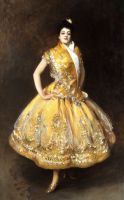Carmen Dauset Moreno
Fields of activity: Flamenco dance, entertainment and publicity.
Biography
She was born in Almeria, an Andalusia town located in the south of Spain. Brought up in a humble family, analphabet grew up imbedded in flamenco, a genuine artistic style of singing and dancing, recently recognized as a universal human heritage . With a tall (1.70m) slender figure, very personal style, drama, seductive smile, loose and long garments, eccentric movements, and with goodbye kisses to audience, she foght her way to fame in USA. She had a full provoking talent: passionate, voluptuous, savage.....very particular way of dancing. She challenged a conservative, puritan environment, and succeeded out of controversy, where neither her image nor her dancing could ever survive.
Her way of dancing was considered both exotic and attractive connecting with the previous idea of romantic-orientalism, she was referred to by critics and journalists as: «The Pearl of Seville», «The Bewitching Spanish Danseuse», «The Wonderful Spanish Dancer», o «The Famous Spanish Eccentric Dancer».
She started in ANTIOPE at Niblo`s (New York), with a short Spanish dance of which a critic would say that “her dance is rare and attractive, just worth visiting Niblo´s”, and “if only, Bolossy Kirafy, in his recent trip to Europe had brought miss Carmencita ‘s attraction, it would have been worth his time and money”.
Her way of dancing raises a critic to question her tone. “It is not a grave epic poem” -he says- “but one savagement passionate, voluptous, and seductive”.
Reaching the fame was not easy. Initially, critics were divided: some did not appreciate her dancing talent, either in New York or the open west. But, she knew well how to sell her image with brief unique appearances, and also, how to profit the opportunity of using halftimes of the fashionable vaudevilles to progressively, introduce her dances. Pioneer of the celebritites merchandising, and one of the first to promote fans clubs, named “Carmencita’s Club”.
Chronology
She danced for the first time at the Cervantes Theatre in Málaga at age sixteen. Between 1885 and 1889, she performed around spanish territory, Lisbon, Berlin, Bohem and Paris, where, while in the Universal Exposition of Paris, acting in the Nouveau Cirque in “la feria de Sevilla. Bolossy Kiralfy, an important New York theatre producer, hired her for a show in New York.
1889-1890: she arrives to New York Augost 17th starting right away in ANTIOPE at Niblo´s Garden, soon followed by a cross-country tour with the same spectacle, introducing spanish dances during half-time intervals.
1890-1891: Back in New York, performs at the famous Koster & Bial’s Concert Hall, and starts being reclaimed at all kinds of private parties. Becomes model of painters like John Singer Sargeant, Thomas Beckwith, or William Merrit Chase, and is homaged at the Madison Square Garden with the first “Carmencita Ball” . Earlier, while dancing in the Boston Tremon Theatre her legs have been insured for 5000 dollars due to the crowd trying to fight their way through.
1892: To cellebrate the 400 anniversary of the America´s discovery, she dances at New York Chickering Hall, accompanied by his brother-in-law, Rojo el Alpargatero singing. This is the earliest testimony of “cante flamenco” in the USA. She marries Pablo Echepare, a musician from the Madrid Royal Music Conservatory .
1893: She continues acting at Koster and Bial’s Music Hall and the Broadway Theatre of New York, where Grover Cleveland, then president candidate, expressly attends to see her.
1894: She is the main actress in two brief kinetoscope films shooted at the Black Mary of Edison study, in West Orange (New Jersey). It is the first cinematic document of spanish dancing, and also, the first time that a woman shows up in a Thomas Alva Edison film.
1895: She comes back to Europe, acting in Palace and St James Theatres in London with little success.
The place and date of her dead are unknown.
- Gelardo Navarro, José (2007): El Rojo el Alpargatero, flamenco. Córdoba: Almuzara.
- Navarro García, José Luis y José Gelardo Navarro (2011): Carmencita Dauset. Una bailarina almeriense. Almería: La Hidra de Lerna/Diputación de Almería.
-
Musser, Charles (1997): Edison Motion Pictures. 1890-1900. An Annotated Filmography. New York: Smithsonian Institution Press.
- Reyes Zúñiga, Lénica y José Miguel Hernández Jaramillo (2012): “El baile de la petenera española del siglo XIX desde una perspectiva etnomusicológica”. En Murga Castro, Idoia, Fuensanta Ros Abellám et alii, Líneas actuales de investigación en danza española. Madrid: Fundación Nebrija, pp. 225-240.
- Mora, Kiko (2011): “Carmencita on the road": baile español y vaudeville en los Estados Unidos de América (1889-1895). Lumiére. http://www.elumiere.net/exclusivo_web/carmencita/carmencita_on_the_road.php
- John Singer Sargent : La Carmencita, vers 1890 (RF 746)
Paris, musée d'Orsay, acquis de l'artiste par l'Etat pour le musée du Luxembourg en 1892
-
Picture source: John Singer Sargent : La Carmencita, vers 1890 (RF 746)
Paris, musée d'Orsay, acquis de l'artiste par l'Etat pour le musée du Luxembourg en 1892
Photo:
- John Singer Sargent's La Carmencita. Public Domain (This work is in the public domain in the United States, and those countries with a copyright term of life of the author plus 100 years or less). http://www.wikiart.org/en/john-singer-sargent/la-carmencita-1890




